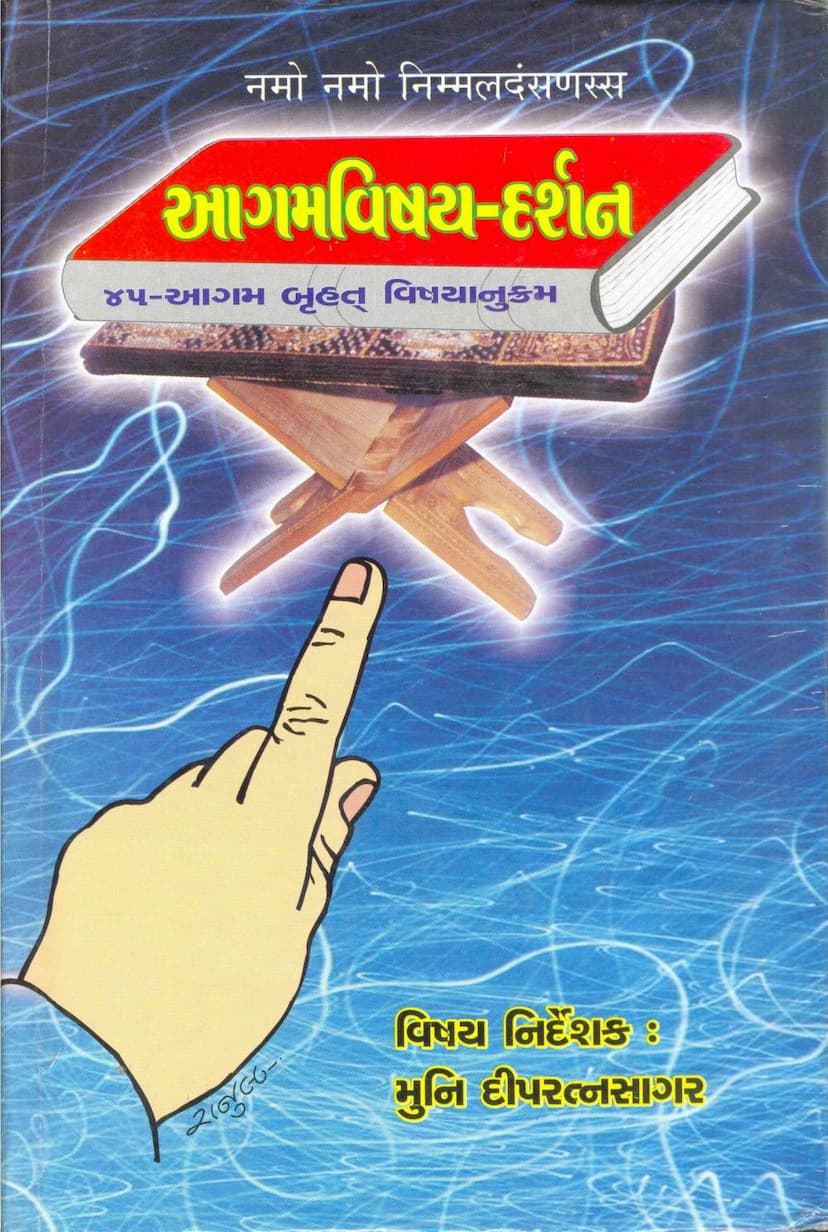Agam Vishaydarshan
Added to library: September 1, 2025

Summary
This Jain text, titled "Agam Vishaydarshan" (Meaning: Insight into the Subjects of Agam), is a comprehensive index and subject guide to the 45 principal Agamas (scriptures) of Jainism, specifically from the Shvetambara Murtipujak tradition.
Here's a breakdown of its content and purpose:
Purpose: The book serves as a detailed subject index for each of the 45 Agamas. It aims to provide a roadmap for understanding the vast subject matter contained within these sacred Jain texts. The title itself, "Agam Vishaydarshan," signifies its role in offering a glimpse into the subjects covered by the Agamas.
Authors: Muni Dippratnasagar and Deepratnasagar.
Publisher: Agam Aradhana Kendra, Ahmedabad.
Content Summary:
The text begins with traditional Jain salutations and acknowledgments, including dedications and financial support from various individuals and institutions, particularly the Shri Vishashri Mali Tapgachh Gnati, Jamnagar, for their generous contribution to the publication.
The core of the book is a meticulous listing of the 45 Agamas, categorized into six main divisions, as is standard in the Shvetambara tradition:
- 11 Angas (Limbs): These are considered the primary Agamas. The book lists them in order, such as Aayar, Suyagada, Thana, Samvay, Vivah Pannatti, Naya Dhamma Kaha, Uvasagadasa, Antagadadasa, Anuttaraupapaticadsa, Pava-vagaranam, and Vivag Suy.
- 12 Upangas (Secondary Limbs): These are considered supplementary to the Angas. They include Upavaay, Rayappraseṇiya, Jivajivabhigam, Pannavna, Surapannatti, Chandrapannatti, Jambudivapannatti, Nirayavaliya, Kappavaddhisiya, Puspaphulia, Pusphachulia, and Vahiddasa.
- 10 Payaṇṇas (Essences/Principles): These texts elaborate on specific principles or practices. They are listed as Chausarana, Aayur Pachchakhan, Maha Pachchakhan, Bhattaparina, Tandulaveyaliya, Samthara, Gachhachar (Chandavedeya), Ganividya, Devindathav, and Maranasamadhi (Viratanav).
- 6 Chedas (Sutras for Discipline): These texts focus on monastic discipline and codes of conduct. They include Nisiha, Brihatkalp, Vavahar, Dasasrutaskandha, Jiyakalp, and Mahanisitha.
- 4 Mulas (Roots): These are considered fundamental texts. They are listed as Aavasyaka, Ohinijutti (Pindanjutti), Dasaveyaliya, and Uttarajjhayana.
- 2 Chulikas (Appendices): These are supplementary texts that further elaborate on the Mulasutras. They are Nandi and Anuyogaddar.
For each of these 45 Agamas, the book provides:
- Agam Number (Kram): A sequential number from 1 to 45.
- Agam Name: The title of the specific Agama.
- Agam Division: The category to which the Agama belongs (e.g., Angasutra, Upangasutra, etc.).
- Page Number (Prushthanka): The starting page number for that Agama's content within the book.
- Subject Index (Vishay Anukram): For many Agamas, particularly the Angas, detailed subject matter indices are provided. These indices break down the content of the Agama into chapters (Shrutaskandh), sections (Udhesh), and specific topics (Anukram), often listing the number of verses (Gatha) and corresponding page numbers for the original text (Moolagam), Gujarati translation (Anuvad), and commentary (Sateek).
Example of Detailed Indexing (for Anga Sutras): The book offers a granular breakdown of some of the key Angas, such as:
- Acharanga Sutra (Angasutra-1): Details chapters like Shastra Pariksha, Lokavijay, Shitooshniya, Samyaktva, etc., with their respective page numbers and verse counts.
- Sutrakruta Sutra (Angasutra-3): Further breaks down content by Shrutaskandh (e.g., Shrutaskandh-1, Shrutaskandh-2) and lists various studies (Adhyayan) like Naraka Vibhakti, Upsarg Parigyna, etc.
- Sthananga Sutra (Angasutra-3): Organizes content by numerical categories, such as Ek Sthan, Do Sthan, Ten Sthan, and so on, up to Dash Sthan.
- Samvayanga Sutra (Angasutra-4): Lists content based on the numerical classification of concepts, from Ek Samvay up to Shat Samvay and beyond.
- Vivahapannatti Sutra (Angasutra-5): Provides a detailed breakdown by Varg (Class) and Shatak (Century/Section) with specific Udhesh (sections) and page references.
- Naya Dhamma Kaha Sutra (Angasutra-6): Similarly indexes content by Shrutaskandh and Adhyayan.
- Upasakadasa Sutra (Angasutra-7): Lists its contents by Adhyayan, focusing on the lives and teachings of lay disciples.
- Antagadadasa Sutra (Angasutra-8): Details the lives of ascetics who achieved liberation.
- Anuttaraupapaticadsa Sutra (Angasutra-9): Describes beings who attained the highest heavens.
- Pava-vagaranam Sutra (Angasutra-10): Covers topics related to the consequences of actions.
- VivahagSutra (Angasutra-11): Focuses on various aspects of existence and the cycle of rebirth.
Additional Sections:
- Agam Vargikaran (Agam Classification): A summary of the six main categories of Agamas and the number of texts within each.
- Prushthanka Visheshtikaran (Page Number Clarification): An explanation that the page numbers provided refer to three different publications: "Moolagam" (original texts), "Agam Deep" (Gujarati translations), and "Navayuttari-Sateek" (commentaries).
- Samavisht Gatha (Included Verses): Clarifies that while verse counts are included in the index, the sequence of verses is also integral to the index itself.
In essence, "Agam Vishaydarshan" is an invaluable reference tool for scholars, practitioners, and anyone seeking to navigate and study the extensive Jain Agamic literature. It systematically organizes and indexes the content of these foundational scriptures, making them more accessible for research and understanding.